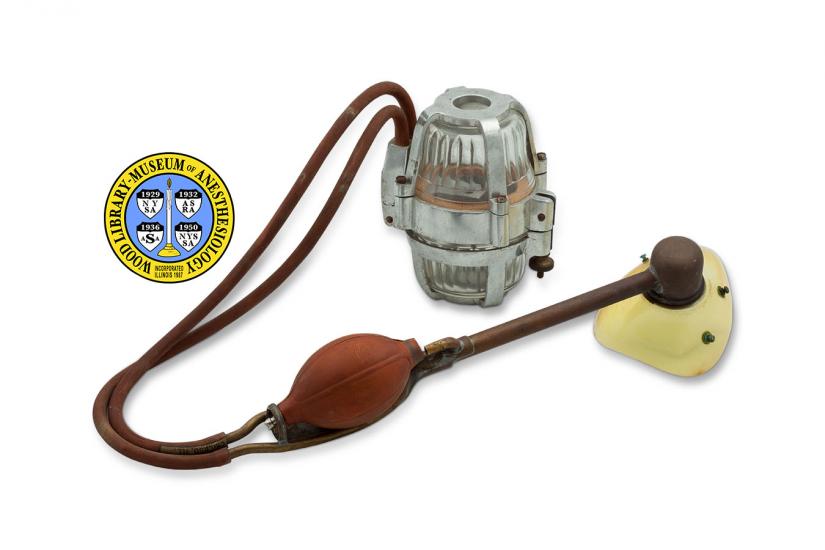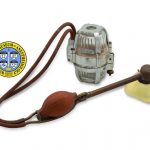Jackson Inhaler
Dr. Dennis E. Jackson (1878-1980) earned a PhD in pharmacology in 1908 and a medical degree in 1913.
He invented a number of anesthesia devices, including this hand-held inhaler. Introduced in 1934, it was meant to be used with any one of several different liquid anesthetics. Dr. Jackson himself used it to administer trichloroethylene analgesia. Trichloroethylene (Trilene) did not produce deep anesthesia, and wore off quickly. It was better suited for pain relief during short procedures, such as might be done in a house call. This portable apparatus fit inside the traditional “doctor’s bag”.
The liquid anesthetic was held in the lower half of the glass reservoir, which would be placed on a nearby table top. Squeezing the rubber bulb added fresh air to the spontaneous vapors of the agent. The celluloid mask could swivel from left to right, compensating for the long, stiff handle. Dr. Jackson thought highly of this anesthetic, and also developed a larger machine for its use. Due to its effects on the environment, trichloroethylene was banned by the FDA in 1977.
Catalog Record: Jackson Inhaler Jackson Inhaler
Access Key: akwn
Accession No.: 1981-12-18-1 D
Title: [ Jackson inhaler.]
Author: Jackson, Dennis E. (Dennis Emerson), 1878-1980.
Title variation: Alt Title
Title: Jackson inhaler.
Title variation: Alt Title
Title: Jackson trichlorethylene apparatus.
Title variation: Alt Title
Title: Jackson hand-driven vaporizer.
Title variation: Alt Title
Title: Jackson hand-operated vaporizer.
Title variation: Alt Title
Title: Jackson hand-powered vaporizer.
Publisher: [Cincinnati?] : [Dennis E. Jackson], [between 1933 and 1936].
Physical Description: 1 vaporizer ; metals, (including aluminum and brass), glass, rubber, celluloid : 20.5 x 42 x 32 cm.
Subject: Trichloroethylene.
Subject: Vaporizers.
Subject: Jackson, Dennis Emerson, 1878-1980.
Web Link: http://woodlibrarymuseum.org/museum/item/772/jackson-inhaler
Note Type: General
Notes: The early year (1933) in the date range for the possible production of this vaporizer is based on the year that Dr. Jackson first reported using this apparatus to test trichlorethylene and divinyl ether (Jackson, 1934). The end date is an estimate, based on the date of the AMA Council on Pharmacy and Chemistry 1936 report, and the lack of any evidence that this apparatus was ever widely used or produced in significant number. The date range most certainly could change if documentation indicates that it should be corrected.
Note Type: General
Notes: Title is taken from the WLM’s common name for the object.
Note Type: Citation
Notes: Council on Pharmacy and Chemistry. Preliminary report of the Council. JAMA. October 17, 1936;107(16):1302.
Note Type: Citation
Notes: Food and Drug Administration. Trichloroethylene: removal from food additive use. Fed Regist. September 27, 1977;42(187):49465–49471. https://archive.org/stream/federalregister42bunit#page/n915/mode/2up. Accessed September 27, 2014.
Note Type: Citation
Notes: Ostlere G. The history of trichlorethylene anaesthesia. Anaesthesia. January, 1953;8(1):21-25.
Note Type: Citation
Notes: Jackson DE. A study of analgesia and anesthesia, with special reference to such substances as trichlorethylene and Vinesthene (divinyl ether), together with apparatus for their administration. Anesth Analg. September-October, 1934;13(5):198-204. http://journals.lww.com/anesthesia-analgesia/toc/1934/09000. Accessed September 27, 2014. [“Read during the Twelfth Annual Congress of Anesthetists, the International Anesthesia Resereach Societv in Joint Meeting with the Associated Anesthetists of the United States and Canada, the Eastern Society of Anesthetists, the Mid-Western Association of Anesthetists and the Southern Association of Anesthetists, Clinical Congress of Surgeons Week, Congress Hotel, Chicago, Ill., October 9-12. 1933. From the Department of Pharmacology, University of Cincinnati Medical School. A preliminary report of this work was read before the Ohio State Medical Association at Akron, Ohio, September 7, 1933.”]
Note Type: Citation
Notes: Stetson JB. Trichlorethylene. Anesth Hist Assoc Newsl. April 1989;7(2):2. http://ahahq.org/Bulletin/AHA_GB_1989-04.pdf. Accessed September 27, 2014.
Note Type: Citation
Notes: Striker C, Goldblatt S, Warm IS, Jackson DE. Clinical experiences with the use of trichlorethylene in the production of over 300 analgesics and anesthesias. Anesth Analg. 1935;14(2):68-71. http://journals.lww.com/anesthesia-analgesia/Citation/1935/03000/Clinical_Experiences_with_the_Use_of.6.aspx. Accessed September 27, 2014.
Note Type: Citation
Notes: Waters RM, ORTH OS, Gillespie NA. Trichlorethylene anesthesia and cardiac rhythm. Anesthesiology. January, 1943;4:1-5. http://journals.lww.com/anesthesiology/toc/1943/01000. [Report cardiac arrhythmias from use of the agent.]
Note Type: Physical Description
Notes: One and-operated vaporizer; The dimensions provided in the physical description field were based on one possible display configuration for the device (similar to how it is displayed in the photograph on the WLM website); The glass and aluminum container alone measures approximately 13.8 cm in height x 9.2 cm in width and 12 cm in depth; The two red rubber tubes that run from the glass and metal container to the connection points on the brass handle measure approximately 46 cm in length; The bulb measures approximately 10.5 cm in length and 5.65 cm in diameter; Measured end to end the handle, including the mask measures approximately 37 cm in length; The celluloid mask alone measured from a patient’s perspective is approximately 10.5 cm in height x 8.6 in width x 3.7 in depth; There are no maker marks on the device.
Note Type: Reproduction
Notes: Photographed by Mr. Steve Donisch, September 17, 2013.
Note Type: Publication
Notes: Buxton PH, Hayward M. Polyneuritis cranialis associated with industrial trichloroethylene poisoning. J Neurol Neurosurg Psychiatry. 1967;30(6):511–518. http://www.ncbi.nlm.nih.gov/pmc/articles/PMC496241/. Accessed September 27, 2014.
Note Type: Publication
Notes: Emil Fischer – biographical. Nobelprize.org. http://www.nobelprize.org/nobel_prizes/chemistry/laureates/1902/fischer-bio.html. Accessed September 27, 2014.
Note Type: Publication
Notes: Final Report on Carcinogens Background Document for Trichloroethylene. National Toxicology Program, US. Department of Health and Human Services website. http://ntp.niehs.nih.gov/ntp/newhomeroc/roc10/tce.pdf. Accessed September 27, 2014.
Note Type: Publication
Notes: Hewer CL, Hadfield CF. Trichlorethylene as an Inhalation Anaesthetic. Br Med J. 1941 Jun 21;1(4198):924-927.
Note Type: Publication
Notes: IARC Working Group on the Evaluation of Carcinogenic Risks to Humans. Trichlorethylene, Tetrachloroethylene, and Some Chlorinated Agents. IARC Monographs. Vol. 106. Lyon, France: International Agency for Research on Cancer; 2014. http://monographs.iarc.fr/ENG/Monographs/vol106/mono106.pdf. Accessed September 27, 2014.
Note Type: Publication
Notes: Jackson DE. A study of analgesia and anesthesia, with special reference to trichlorethylene [edited reprint with comments]. J Am Dent Soc Anesthesiol. March, 1959;6(3):13–16. http://www.ncbi.nlm.nih.gov/pmc/articles/PMC2067400/. Accessed September 27, 2014.
Note Type: Publication
Notes: Ochsner JC, Blackwood TR, Micheleitti WC. Status assessment of toxic chemicals: trichloroethylene. Cincinnati, Ohio; Industrial Environmental Research Laboratory, U.S. Environmental Protection Agency; December, 1979:3. http://nepis.epa.gov/Simple.html. Accessed September 27,2014.
Note Type: Exhibition
Notes: Selected for the WLM website.


